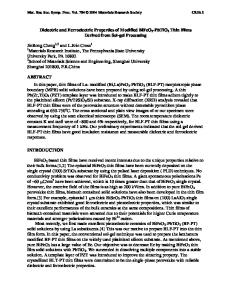Sol-Gel Processing of PbTiO 3 Fibers
- PDF / 861,215 Bytes
- 6 Pages / 420.48 x 639 pts Page_size
- 42 Downloads / 313 Views
SOL-GEL PROCESSING OF PbTiO3 FIBERS S.I. Aoki, S. C. Choi*, D.A. Payne** and H.Yanagida RCAST, The University of Tokyo, 4-6-1 Komaba, Meguro-ku, Tokyo, Japan 153 *Department of Materials Science and Engineering, Ajou University, Suwon, Korea "**Department of Materials Science and Engineering, University of Illinois at UrbanaChampaign, 105 South Goodwin Avenue, Urbana, IL 61801. ABSTRACT Lead titanate fibers were formed from lead acetate and titanium isopropoxide by sol-gel methods. Additions of acids and chelating agents were used to influence hydrolysis and condensation reactions. A variety of solvents were examined, and the effect of conditioning treatments at elevated temperatures were investigated. Data are reported for the rheological behavior of viscous sols, fiber drawing ability, pyrolysis and crystallization of gels and fibers. Features of the ceramic microstructure are reported. A pyroelectric effect was measured for PbTiO3 fibers. INTRODUCTION Lead titanate is a ferroelectric material with the perovskite structure, and is a potential candidate for high temperature pyroelectric sensing applications due to its high Curie point (5000C) and spontaneous polarization (0.8 C/M2 ). A fibrous form is the preferred geometry for the reduction of heat capacity and increased responsivity in small scale devices. Hence, the interest in the sol-gel processing of lead titanate fibers. Recently, many kinds of oxide ceramics have been prepared from metal alkoxide solutions by sol-gel processing. In general, the method allows for of unusual forms, like reductions in firing temperatures and for the preparation continuous fibers. In previous work, Si02,1 TiO2, 2 and ZrO2 3 fibers were formed from corresponding metal alkoxide solutions. Little has been reported for the preparation of ferroelectric fibers. Fibers are usually drawn from viscous sols of high concentration, and with a preferred linear polymeric structure. It is important to control hydrolysis and condensation reactions, and to derive processing conditions for the accelerated volatilization of solvent. The latter can concentrate polymeric solutions without immediate gelation. In this study, we report on the processing of lead titanate fibers derived from a lead acetate and titanium isopropoxide solution. Emphasis is placed on the processing conditions necessary for the drawing of continuous fibers. EXPERIMENTAL PROCEDURE Figure 1 illustrates the flow diagram for the process. A 1M stock solution of a Pb-Ti alkoxide complex was prepared from an equimolar anhydrous lead acetate and titanium4 isopropoxide solution according to a method originally reported by Budd et al., and with modification. Three anhydrous alcohols (methanol, 2propanol and methoxyethanol) with different boiling points (651C, 78 0C, 1250 C, respectively) were evaluated as suitable solvents. A 5ml alcoholic solution, which contained 0.01 mol of water, 0.005-0.02 mol acetic acid (AcOH) and 0-0.02 mol acetylacetone (acac), was added dropwise to 5ml of the stock solution, (i.e., 0.005 mol Pb-Ti alkoxide)
Data Loading...











